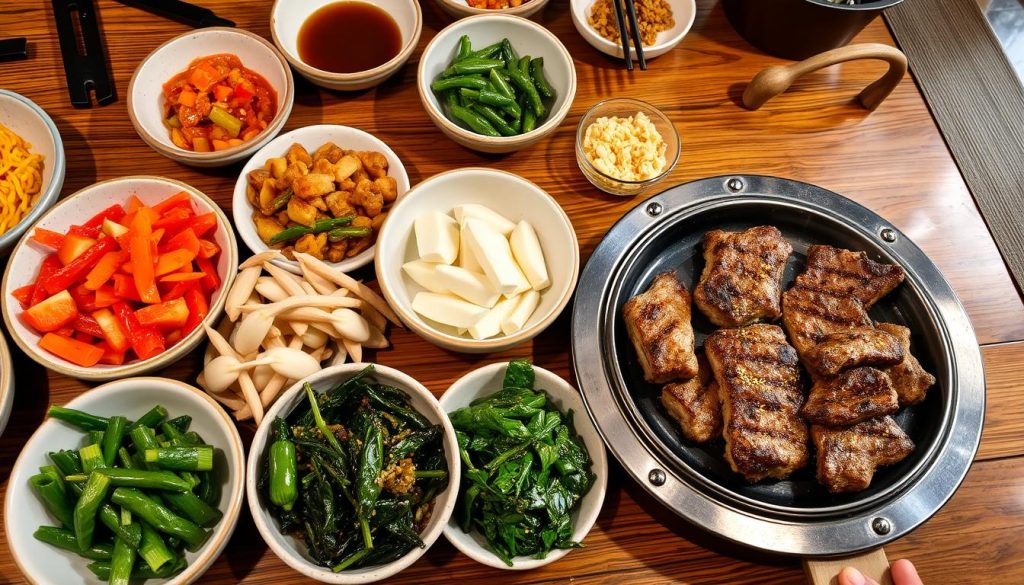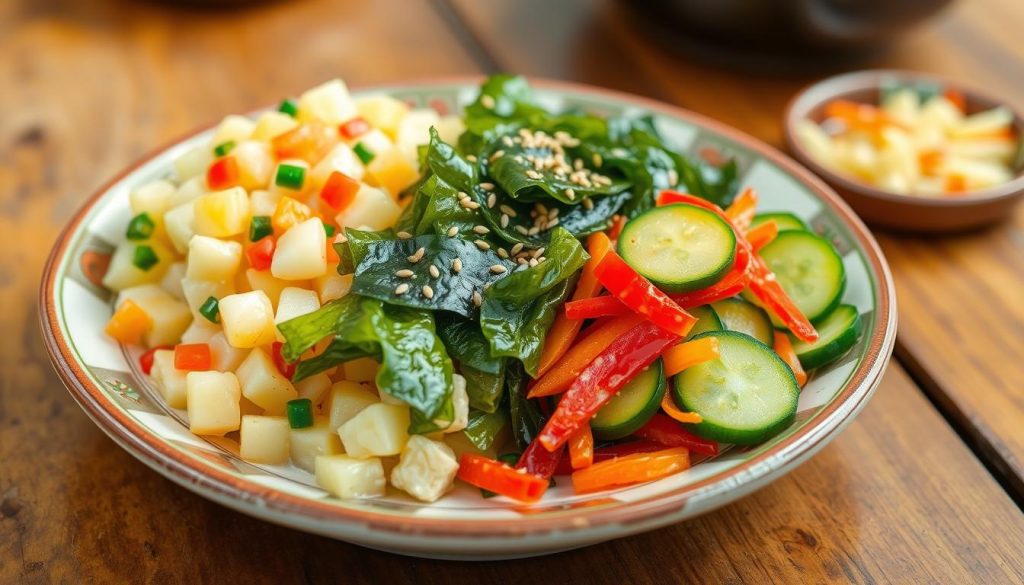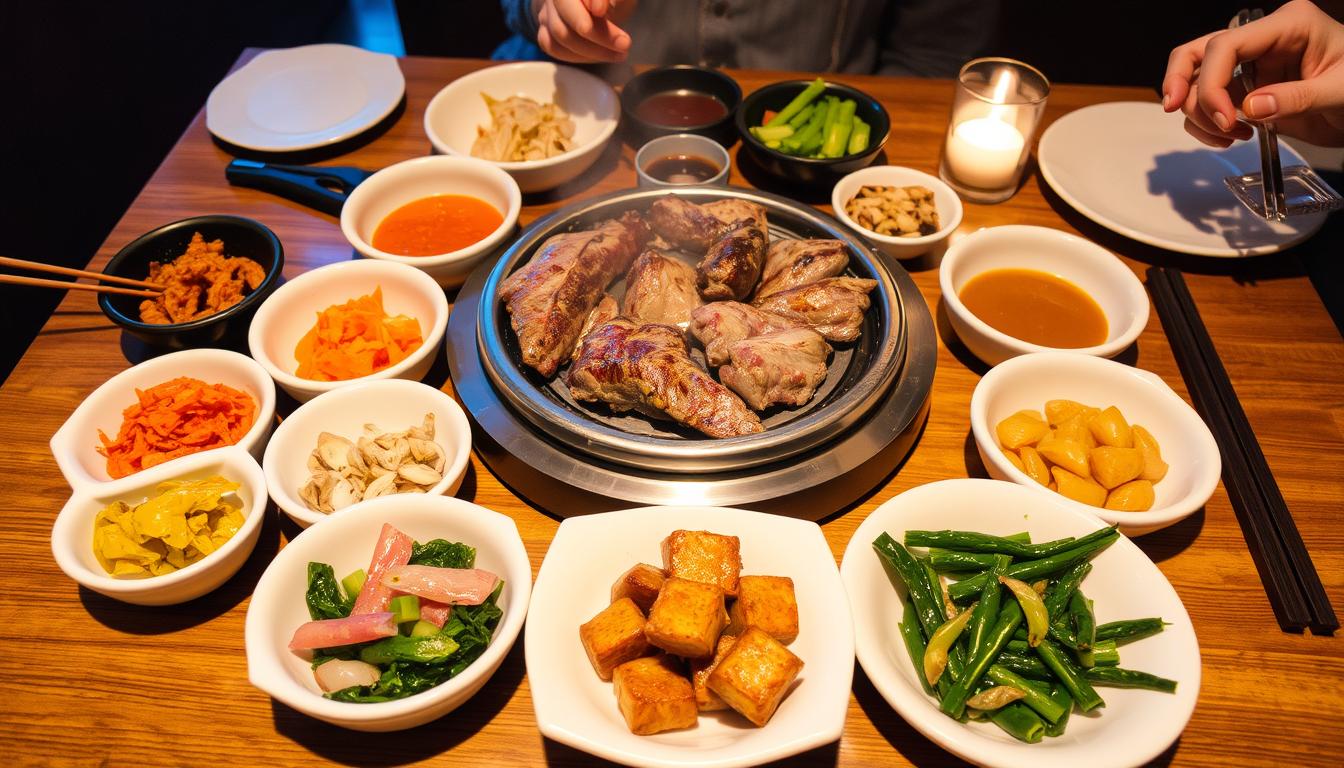Welcome to the world of bulgogi side dishes. Here, you’ll find out how to make your meals better with Korean cuisine. Bulgogi, a favorite marinated beef dish, gets even better with the right sides, called banchan. This guide will show you 15 great side dishes that go well with bulgogi, making its flavors and textures even richer.
There are crunchy salads and savory vegetable dishes like tofu, zucchini, and radish. Each side dish is key to a balanced meal. Notably, 4 of these 15 dishes feature beans or sprouts. An amazing 13 are plant-based, offering a tasty mix for everyone. You’ll see how these perfect pairings make your meal even better.
The Essence of Bulgogi
Bulgogi is a beloved dish in Korean cuisine, known for its rich flavors and marinated beef. It’s often grilled or stir-fried. The essence of bulgogi has a long history, dating back to the Goguryeo era, around 37 BC to 668 AD.
This recipe evolved a lot during the Joseon Dynasty. It changed from skewered meat to the grilled version we love today.
Understanding Bulgogi
This dish uses boneless ribeye steak, known for its tenderness and flavor. It’s sliced very thin, about 1/8 inch, for quick and even cooking. Slicing against the grain makes the meat tender after cooking.
Marinades include soy sauce, brown sugar, sesame oil, and garlic. Grated Korean or Asian pear is also used, as it tenderizes the meat.
The Flavor Profile of Marinated Beef
The flavor of marinated beef is bold, mixing sweet and savory tastes. Marinating the beef for at least 30 minutes, or better yet, overnight, adds deep flavor and tenderness.
It can be cooked by pan-frying, grilling, or barbecuing at medium-high heat. Frequent flipping prevents burning and ensures even cooking. Serve it with steamed rice, lettuce wraps, and banchan like kimchi for a full experience.
What Makes a Great Bulgogi Side Dish?
Finding the right side dish for bulgogi is key to making the meal better. A great side dish adds flavor, texture, and cultural depth. These elements are crucial for a memorable dining experience.
Balancing Flavors
Flavor balance is essential for bulgogi side dishes. The beef’s rich taste needs sides that contrast or complement it. Kimchi, with its salty, spicy, and tangy flavors, pairs well with bulgogi’s sweetness.
For a lighter option, try Korean spicy cucumber salad, or Oi Muchim. It adds a refreshing twist to the meal.
Texture Considerations
The texture of side dishes greatly affects the meal’s enjoyment. Crunchy vegetables like Mu Bokkeum Namul provide a nice contrast to the meat. Korean fried rice, with kimchi, adds a creamy texture that enriches the meal.
This variety in texture makes each bite exciting. It turns your bulgogi meal into a memorable feast.
Cultural Significance of Banchan
Banchan, or Korean side dishes, hold deep cultural meaning. They symbolize communal sharing, unity, and hospitality. A diverse selection of banchan enhances your dining experience, showing the love and care in each dish.
With roots in Korean tradition, serving a variety of side dishes turns your meal into a cultural journey. It invites guests to enjoy both flavors and history.
Popular Bulgogi Side Dishes to Try
Choosing the right side dishes can make your bulgogi meal even better. Different sides add flavors and textures that make the meal more enjoyable. Some side dishes are especially good with bulgogi.
Kimchi: A Traditional Favorite
Kimchi is a big part of Korean food, often eaten with many meals. It’s made from napa cabbage and Korean chili flakes. This gives a tangy taste that contrasts well with bulgogi.
Kimchi also has health benefits from its probiotics. You can pick from many types of kimchi, each with its own flavor.
Steamed Rice: The Perfect Base
Steamed rice is a great base for bulgogi. It has a neutral taste that lets the beef stand out. The soft rice absorbs the juices from the bulgogi, making each bite tasty.
This combo is comforting and key in Korean meals. It makes sure your meal is complete.
Japchae: Sweet Potato Noodles
Japchae is a tasty choice for a side dish. It’s made from sweet potato noodles and has veggies like carrots and spinach. Stir-fried to perfection, it adds a chewy texture to your meal.
The slight sweetness of japchae goes well with bulgogi. It creates a nice mix of flavors.

Exploring Unique Side Dishes
Adding unique side dishes to bulgogi can make the meal better. Korean potato salad is a standout with its creamy texture and sweetness. It balances the savory bulgogi flavors. Seaweed salad is light and refreshing, adding health benefits. Spicy cucumber salad adds a crunchy, spicy kick.
These side dishes encourage creativity and offer exciting flavors.
Korean Potato Salad: A Creamy Delight
Korean potato salad is a comforting, creamy addition. It’s made with mashed potatoes, mayonnaise, and vegetables. This sweet dish pairs well with bulgogi, offering a rich texture.
Seaweed Salad: Light and Refreshing
Seaweed salad adds freshness to your meal. It’s seasoned with sesame oil and sesame seeds. This light salad enhances the bulgogi feast with essential nutrients.
Spicy Cucumber Salad: A Burst of Heat
Spicy cucumber salad is great for those who like spice. It has crisp cucumbers in a spicy mix of gochugaru and vinegar. This side adds a fiery kick to the meal, balancing the rich bulgogi flavors.

Bulgogi Side Dishes Guide
Enjoying bulgogi is better with the right side dishes. This guide will show you the best sides to try. You’ll learn about traditional Korean banchan and tasty vegetable options.
Classic Korean Banchan to Elevate Your Meal
Classic banchan is key to a great bulgogi meal. These small dishes add variety and balance. Here are some favorites:
- Kimchi: Fermented veggies that add a spicy kick.
- Pickled radish: Refreshing and a nice contrast to bulgogi.
- Seasoned soybean sprouts: Nutritious and flavorful, making the meal better.
- Sautéed broccoli with sesame and garlic: A crunchy and tasty choice.
In traditional settings, serving an odd number of banchan, like five, is seen as lucky.
Vegetable Options: Grilled and Stir-Fried Choices
Adding vegetables makes your bulgogi meal healthier. Grilled zucchini, eggplant, and stir-fried mushrooms go great with the beef. They add color, texture, and flavor that match bulgogi’s savory taste.
Alternate Carbohydrate Pairings: Brown Rice and Fried Tofu
Looking for different carbs? Brown rice has a nutty taste that’s great with bulgogi. Fried tofu is a protein-rich choice with a nice crunch. It’s perfect for soaking up bulgogi’s juices. These options make your meal more balanced and satisfying.
How to Serve Bulgogi with Side Dishes
Serving bulgogi well means creating a fun experience with great flavors, textures, and colors. A good presentation can turn a meal into a special event, especially at festive times. To do this, aim for a balanced plate that shows off each dish and makes the meal better.
Creating a Balanced Plate
A balanced plate is key when serving bulgogi. Think about these important points:
- Flavors: Mix sweet, savory, and spicy sides to match bulgogi’s rich taste.
- Textures: Add crunchy, soft, and chewy sides for a fun mouthfeel.
- Colors: Use bright veggies to make the plate look inviting.
Popular sides include kimchi, seasoned vegetables, and steamed rice. Place them around the bulgogi to make the dish look good and taste great.
Serving Suggestions for Festive Occasions
At festive times, serve bulgogi in traditional ways to make the meal more special. Here are some ideas:
- Korean Dining Etiquette: Put the rice bowl to the left of the bulgogi and soups. This follows customs that mean harmony at the table.
- Create Ssam Packs: Have guests make ssam packages with bulgogi, rice, and sauces in leafy greens.
- Offer Plenty of Banchan: Serve 8-10 side dishes to make the meal richer and more like a Korean feast.
By focusing on a balanced plate and fun presentation, serving bulgogi will be a hit with your guests.
Conclusion
Exploring bulgogi pairings and side dishes can really make your meal better. You can choose traditional items like kimchi and japchae or try vegan versions. Korean cuisine is full of options for your dinner table.
Banchan, or side dishes, are key in Korean meals. They add flavor and depth to your main dish. When cooking, add Korean flavors to your sides. Feel free to mix things up and find new favorites.
Embrace the world of bulgogi pairings with an open mind. The right choices can turn a simple meal into a special experience. Korean cuisine is all about tradition and taste. Start experimenting with different side dishes and make your kitchen a place of creativity.
Source Links
- https://www.corriecooks.com/bulgogi-sides/
- https://mykoreankitchen.com/bulgogi-korean-bbq-beef/
- https://amazingfoodanddrink.com/recipes/traditional-korean-bulgogi/
- https://www.davidlebovitz.com/chicken-bulgogi-dak-korean-recipe/
- https://girlscangrill.com/recipe/beef-bulgogi-salad/
- https://www.carolinescooking.com/beef-bulgogi/
- https://gustomeadow.com/bulgogi-sides/
- https://www.justonecookbook.com/bulgogi-korean-grilled-beef/
- https://www.sevenspicelife.com/seven-spice-life-food-blog/2019/5/14/korean-side-dishes-banchan
- https://mykoreankitchen.com/category/side-dishes-banchan/
- https://www.pinterest.com/ideas/sides-for-bulgogi/915303014694/
- https://www.pinterest.com/ideas/bulgogi-side-dishes/942354839915/
- https://chefchrischo.com/korean-bbq-at-home/
- https://www.seriouseats.com/how-to-eat-korean-food
- https://tastecooking.com/shattering-the-beef-bulgogi-ceiling/
- https://eattheworldto.com/2022/08/11/south-korea-a-guide-to-korean-food-for-beginners/
